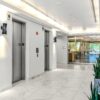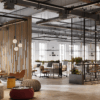Many are comparing the economic challenges of COVID-19 on commercial real estate to that of the last recession. But CRE was in a much stronger position before the 2020 pandemic than it was in 2008.
And although CRE—and the entire world—will operate differently moving forward, experts say CRE will bounce back.
Brokers recently reported they expect to sell and lease office, industrial, and retail the most in 2020. With effects of COVID-19 on commercial real estate and the larger sector, here’s what you need to know about each of these property types this year:
Office spaces are still going to be needed, but more for collaboration and innovation than day-to-day work
The office sector took a hit as a direct result of the COVID-19 outbreak—down 17% year over year since mid-April according to a recent report by Deloitte. Businesses across the country have moved to entirely remote offices to prioritize employee health and well-being.
Some companies hope to be back to work in their offices soon, while others, like Google, are saying that they are extending their work from home options through next year.
Here’s the question: will we need office spaces in the future? The short answer is yes.
JLL believes that physical interaction is a key catalyst for innovation in business, and that office spaces will primarily be a place for collaboration rather than for day-to-day work.
But offices will look entirely different—each with more space between desks, a strict sanitation regimen, and flexible working options. This will mean fewer people in the office at a time, and always sitting 6 feet apart.
The effects of COVID-19 on Commercial Real Estate Owners & Investors
Moving forward, businesses signing leases for office space will look for flexible terms on their contracts. With uncertainty around their total number of employees, and remote working becoming more likely more days a week—employers will seek contracts that allow for flexibility.
And because offices will be used more for collaboration than day-to-day working, office spaces will need to be set up to foster this type of work.
Depending on what experts recommend, this could mean the end of the traditional cubicle work setting and a more open-concept workspace for safe, larger group meetings.
Traditional retail spaces need to adapt to meet new consumer demands
Retail businesses across the country are suffering as they’ve been forced to shut their doors to protect public health. Deloitte’s recent report found that as of mid-April, the retail sector has dropped 53% year-over-year.
Unfortunately, malls and traditional brick-and-mortar retail locations have been fighting to stay alive for years as foot traffic to physical stores has declined and online shopping rises. But these locations have been and are continuing to adapt to meet the demands of their customers.
JLL says that for some, the current loss of revenue from retail locations can be recouped in other ways. For example, restaurants across the country are staying open for delivery and pick-up, and some are even turning into supermarkets to sell their ingredients to customers.
Other retail locations are getting creative too—like Warby Parker offering virtual try-on to encourage sales while customers can’t visit their stores.
What does this mean for owners and investors?
For retail clients, their primary focus now will be preserving cash. But sooner or later, retail locations will need to revamp how they approach their operations to keep up with the online demand. You may consider searching for additional industrial investments, as the need for more inventory storage increases.
On the flip side, JLL says that some retailers will be looking to clear the surplus of stock they’ve collected during the COVID-19 pandemic and will consider opening outlet stores to clear stock. Retailers could be looking for additional storefronts in the not so distant future.
Industrial spaces are doing well, but concerns arise from the essential workers
More than ever, the role of the industrial sector is critical to the global economy. The supply chain is keeping many businesses afloat during the COVID-19 crisis.
Before the pandemic, the industrial sector was strong. JLL says demand was robust and vacancy rates were at near-record lows. And as of mid-April, Deloitte reported that industrial was up 14% year over year.
But concerns are already arising with low oil prices and demand, supply chain bottles necks, and spending slowdowns. In fact, a recent survey of manufacturers found that 78% anticipate a financial impact.
Experts seem to be cautiously optimistic about the industrial space, but changes are already anticipated as they relate to operations.
What does this mean for owners and investors?
With industrial clients, their immediate focus will remain on supply chain risk mitigation and resilience.
As most manufacturing jobs require workers to be in-person, and with fewer people being allowed in factories at a time, the look of the industrial spaces sold and leased will likely change as well. Working conditions will have to adhere to new social distance policies for the health and safety of essential workers.
Also, as the construction of new industrial spaces continues, brokers will need to come up with innovative ways to showcase these properties to buyers.
Virtual tours, while becoming more popular before the pandemic, are likely going to be the primary way you can deliver tours.
Want more COVID-19 CRE updates?
We’re staying up to date on everything you need to know. Head to Buildout’s COVID-19 resources page for the latest news on how the pandemic is impacting the commercial real estate industry.
support@buildout.com

















